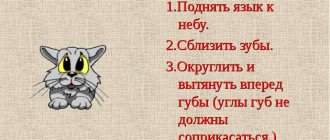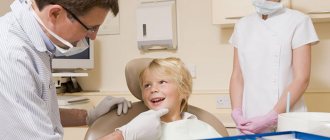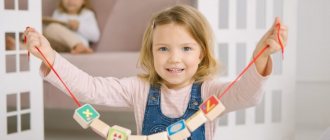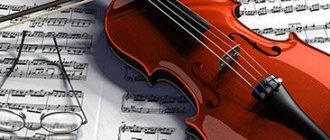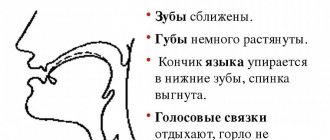July 16, 2018
Averyanova Sveta
Pronouncing the hard and soft sound “r” is rarely easy for children. In speech therapy, there is even a special “indulgence” for “l” and “r”: if for the basic alphabet the norm of development is within 4 years, then for “l” and “r” experts allocate two more preschool years - up to 6 years .
When preparing for school, teachers especially focus the attention of parents on how to teach their child to say the letter “R”. In school education, incorrect pronunciation can become a problem for a child, first of all psychological, and then communicative. A careful attitude to children's speech at 2-4 years old can correct the situation.
When correction is needed
The sound “R” is one of the most difficult sounds in a child’s speech development. It belongs to the category of sonorants, in which there are more vocal tones than noise.
Experts put “P” last, when all other sounds have already been correctly formed and consolidated. The production of “R” begins after 5.5-6 years. Until this time, a violation in his pronunciation is the age norm.
In some cases, it is worth contacting a speech therapist from the age of 4, when “R” appears in speech, but does not manifest itself correctly. In this variant, the child does not replace “R” with other sounds (“L”, “V”), but tries to pronounce “R”, but with disturbances in the articulatory apparatus.
Norm for pronunciation of “R”:
- lips are relaxed;
- distance between teeth 4-5 mm;
- the tip of the tongue rises to the upper gums;
- the tongue vibrates in the air stream;
- the middle part of the back of the tongue arches;
- the back of the tongue is directed back, pressed against the palate;
- the side edges are pressed upward;
- The vocal folds vibrate when speaking.
Violation of the pronunciation of hard “P” and soft “Pb” in defectology is called rhotacism or pararotacism. In Soviet times, these violations were called burrs.
The main types of rhotacism that require correction:
- Velar. The tip of the tongue is lowered down and does not participate in articulation. The tongue is tense and pushed back. There is little voice in pronunciation, a lot of air. The sound is guttural and loud.
- Uvular. The tongue vibrates in the air stream. The sound is soft, quiet, smooth.
- Nasal. The air is directed into the nose, there is no vibration.
- Bilabial. Only the lips, without the tongue, take part in articulation.
- Slotted. The tongue is directed upward and forms a gap with the soft palate. The sound changes to “Z” or “Zh”.
- Interdental. The tongue is between the teeth.
Stages of correction of violations:
- Preparatory.
- Sound production.
- Automation.
- Differentiation.
- Consolidation in speech.
Drawing up a correction program
It depends on the form of the sound pronunciation disorder. For example, a child may have no vibrant in his speech at all, or he may replace it with other sounds or mix them. Rotacisms, that is, distortions, are also common. There are 8 types of rotacisms. Therefore, the speech therapist selects a step-by-step production of the sound “r” individually for each little patient. However, there is a list of exercises that are suitable for any form of vibrant pronunciation disorder.
“Imitation” technique for simple cases
The staging exercise involves auditory perception of sound. The little student is offered examples of phonemes, for example, the roar of a motor, thunder. And he, sitting in front of the mirror, repeats what he heard.
Reasons for incorrect pronunciation
A set of art exercises.
Forms of rotacism:
- Distorted pronunciation.
- Lack of sound in the child's speech.
- Replacing one sound with another.
Causes:
- Disorders of articulatory motility and the structure of the articulatory apparatus: short frenulum, narrow or enlarged tongue, malocclusion, lack of teeth, high palate.
- Violation of central regulation of breathing. The rhythm and coordination of inhalation and exhalation are disturbed. Exhalation occurs through the nose during throat pronunciation. The defects are caused by changes in muscle tone, limited mobility of the muscles of the larynx, soft palate, vocal folds, tongue and lips.
- Pedagogical neglect. The child does not hear literate speech in everyday situations; there is no literacy training. Adults consciously imitate his pronunciation, changing sounds, and do not correct incorrect sounds. They do not read literary works to a preschooler, nor do they have long conversations with him.
- Phonemic hearing impairment. The child does not distinguish phonemes of his native language, mixes them up, and does not understand the speech of others well.
Speech breathing problems
Speech breathing is the basis of spoken speech. It is responsible for voice-forming and articulatory functions. Speech breathing is the ability of a person to take a short, deep breath and distribute the air when exhaling while simultaneously pronouncing various sounds. Inhalation is 5-8 times shorter than exhalation. The long-term output is where speech is formed. With correct speech breathing, the child speaks clearly and expressively, observing pauses.
Preschoolers do not control themselves, they begin to speak while inhaling or on the residual output, and take in air before pronouncing each word. This affects correct pronunciation. If the child does not pronounce “R”, correction work should begin with breathing.
Hearing impairment
Phonemic hearing is the ability to distinguish, analyze and differentiate heard phonemes. From birth, children master their native speech by imitation. By the age of 4, a preschooler has developed the technique of pronunciation of all sounds, except sonorous ones.
Impaired phonemic hearing (dyslalia) complicates the perception of oral and written speech in school education, therefore, correction of defects is necessary as soon as they are detected.
Speech therapy exercises for the development of phonemic hearing, which parents can do independently:
- The adult names a series of sounds, and the child claps his hands when he hears the one in question.
- The adult claps his hands or taps a pencil in a rhythm that the child must repeat.
- The adult dictates sound combinations, the child repeats them.
- The adult shows the pictures, the child chooses those with the hidden sound.
- The adult names the words correctly and incorrectly, the child claps his hands when he hears the correct option.
Automation of the letter "P".
Insufficient development of speech organs
Immaturity of the speech apparatus is the main cause of pronunciation problems in preschool children. The speech apparatus consists of 2 sections: central (brain sections) and peripheral (tongue, lips, soft palate, lower jaw). Brain disorders are diagnosed and corrected by a neuropsychologist. Defects in the articulatory apparatus are eliminated by a speech therapist-defectologist in a playful manner.
Individual structure of the frenulum
A shortened frenulum and anomalies in its location are a defect of the oral cavity that occurs in early childhood. The problem can be effectively solved surgically; if you contact a specialist in a timely manner, the hypoglossal ligament is stretched with the help of exercises and speech therapy tools.
What specialist help may be needed?
If the cause of a speech defect in a child is a shortened hyoid frenulum, then consultation with a surgeon may be required. But in modern speech therapy they solve this problem with the help of exercises. And only those who have a too short frenulum need the help of a surgeon. This defect makes it difficult to raise the tongue, which is the basis for the pronunciation of R.
If your bite is incorrect, your speech therapist may advise you to see an orthodontist. If there is a complex speech disorder (dysarthria, alalia), to activate speech processes you need a special course of treatment, which is selected by a neurologist. As well as a consultation with a defectologist who can draw up a plan for corrective work on the development of the emotional-volitional sphere.
Preparation of the articulatory apparatus
In correctional classes, the preparatory stage is devoted to working with the articulatory apparatus. Exercises are performed to stretch the hyoid ligament, lift the tongue upward, and warm up the lips and jaw.
Tasks for preparing the articulatory apparatus for work:
- “Swing” - open your mouth, stretch your tongue alternately to your nose and chin.
- “Horse” - click your tongue slowly and forcefully, imitating the sound of a horse’s hooves, while the lower jaw remains motionless.
- “Chatter” - use the wide tip of your tongue to run back and forth along your upper lip, without lifting your tongue. Simultaneously say “BL-BL-BL”.
Gymnastics for lips
The complex includes 3 exercises:
- "Let's smile!" The baby smiles, showing all his teeth. The duration of the approach is 5 seconds.
- "Tube". There are 2 variations of this exercise. The student stretches out his lips, imitating a tube, silently “reproduces” the sound “u” or closes his teeth and slightly stretches his lips forward so that a square is formed.
- "The doors are opening." The baby slowly opens his mouth so that there is a distance of 10 mm between the teeth of both jaws.
Then he smiles, showing his teeth.
Breathing exercises
Breathing speech therapy gymnastics:
- "Bubbles." Take a deep breath through your nose, puff out your cheeks and exhale through your mouth.
- "Mill". Feet together, arms up. Rotate with straight arms, saying “zh-r-r” as you exhale. Speed up movements, increase sound.
- "Geese." Walk around the room, flapping your arms like wings. Raise your arms as you inhale, lower them as you exhale, saying “g-oo-oo.”
- "Balloon". Lying on your back, place your hand on your stomach. Take a deep breath and exhale, observing the movement of your hand. Inflate your belly like a balloon.
- "Hedgehog". Imitation of a hedgehog puffing with tension in the muscles of the nasopharynx.
Sound production methods
Tongue twisters for pronunciation of the sound “r”.
Basic staging techniques:
- By imitation - the child’s attention is fixed on movements, positions of the organs of articulation using visual and auditory control.
- Mechanically - using speech therapy probes, spatulas, hand tools.
- Mixed method - production from other sounds.
The period for fixing the correct sound is from 25 to 60 days. Lessons are held 2 times a week, without a speech therapist at home they study daily.
Imitation
Until the age of 6 years, pure “P” and “Pb” appear in children by imitation. The child masters articulation independently through phonemic perception, focusing on the speech of the people around him. Therefore, the pronunciation of adults should be clear and clear, without violations.
Setting "R" from the sound "D"
You can teach your child to say the letter “R”, starting from already formed sounds.
Setting from “D”:
- The child pronounces “D” loudly. The tip of the tongue rests on the alveoli of the upper palate. The tongue does not leave the palate.
- Repeat “Ddddd” without stopping. The tongue will vibrate and “DDD-RRR” will appear.
- Say the syllables DRA, DRO, DRU, DRE, DRA, in which the “R” sounds hard.
- Pronounce words that begin with “DR”, “TR”, practice pronunciation.
- Remove "D" from exercises.
If your child is unable to vibrate his tongue, you can help him by gently nudging his tongue with a popsicle stick.
Exercises from the sound “Zh”
If a preschooler pronounces “F” correctly, then when pronouncing it, you can move the tongue with a stick deeper into the mouth. A short “R” is formed. Strengthen it by repeating the exercises. After automating “R”, select words without using “F”.
Setting from the sound “Z”
The child pronounces “Z” briefly, lightly touching the alveoli with his tongue, and blows strongly on the tongue. A single-beat “P” will be heard, which then easily turns into a vibrating one.
This method is rarely used in practice, because The articulation of “R” and “Z” is different.
Exercises from the sound “C”
The child pulls “Ssssss” for a long time, then inhales through the mouth and presses the tongue to the alveoli. A short “P” will appear, which is automated through the exercises described above.
On inspiration
A distinctive feature of the above method is that the sound is caused by inhalation. Speech is built on a long exhalation, while the inhalation during speech breathing is short. But when placing “P” from “S”, the child makes a sound while inhaling air.
Ways to make the sound “r”.
Mechanical method
“P” is placed mechanically using speech therapy instruments. The child opens his mouth and raises his tongue to the sky. The speech therapist taps the alveoli with a hammer and adds vibration with a spatula. The sound is fixed with the help of exercises, vibration is practiced, first with a spatula, then without it.
Vibration of the tongue can be obtained in the following way: place a thick ball of paper (tied to a long thread) on the tip of the tongue, remove the tongue by the upper teeth and blow it off the tongue with a strong stream of air.
The mechanical method is used with caution in play so as not to injure the preschooler.
How a child’s speech is formed from birth to 3 years
The baby learns to communicate with the outside world from the very moment of birth. Let's take a look at how the speech development of young children proceeds during the first 3 years of a child's life. Norms of speech development in children from 0 to 3 years
- 0 – 2 months. Scream. The first form of communication for a child is crying. The baby cries when he is hungry, uncomfortable or tired.
- 2 – 3 months. Booming. Crying is replaced by cheering. The sounds “a”, “s”, “u” appear, sometimes in combination with “g”. The child learns to understand speech addressed to him and control his own sound intonations.
- 3 – 6 months. Babble. The baby begins to babble to himself and make sounds when addressed to him. Turns his head towards the sound. Freezes in response to a sudden loud sound. Cries differently depending on needs: “I’m hungry,” “I’m tired.” Recognizes his name and reacts to it.
- 6 months. First syllables. From the age of 6 months, you can notice that the child prefers strictly certain sounds to all others: “ba”, “ma” (they are the easiest to learn to pronounce). He can repeat them endlessly: he likes the way they sound.
- 7 – 9 months. Combinations of syllables. The babbling progresses to the utterance of identical syllables: “ma-ma-ma”, “dya-dya-dya”, “ba-ba-ba”.
- 9 – 11 months. Onomatopoeia. The baby imitates the sounds of adults' speech. Responds to name. Understands the meaning of the word “no.”
- 11 – 13 months. The first meaningful words from two identical syllables: “dad”, “mom”, “baba”, “uncle”. 12 months. The baby shows interest and attention to the speech of others, repeats and combines sounds in a new way, combines them into “words”, imitating the speech of an adult. Understands and follows simple one-word instructions (“sit down”). He waves his hand “bye-bye”, shakes his head “no”. Uses gestures and sounds to attract attention. Interested in books.
Rarely does a parent know what signs indicate deviations in the child’s development. Therefore, for prevention, be sure to visit a pediatric neurologist at 3, 6, 9 and 12 months.
- 18 months. The baby easily repeats frequently heard words. Knows different parts of the body and points to them. Masters simple words (by the age of 2 years, their vocabulary can range from 20 to 50). Answers in words or gestures the questions: “Where is the bear?”, “What is this?” He loves when people read to him. At the request of an adult, he points his finger at the pictures in the book. 2 years. First sentences (two words). A two-year-old child can easily combine simple words mastered by the age of 2 into combinations: “Mom, give me,” “I want this,” “Where is the kitty?” Understands simple instructions consisting of two sequential actions: “Find your teddy bear and show it to grandma.” The vocabulary can expand to 150 - 200 lexemes, and others can already understand half of the words the child pronounces. The baby begins to use pronouns, adjectives and prepositions. Holds a book correctly in his hands. “Reads” to his toys.
- 3 years. Multi-word sentences (three or more words). At 3 years old, the period of early childhood ends. By this turning point, the child is able to compose sentences of three or more words. Distinguishes between colors and size definitions. Remembers and repeats familiar rhythms, melodies, stories. Some difficulties in sound pronunciation may still persist (whistling, hissing, vowel sounds). The vocabulary is expanding so much that parents can no longer accurately count how many words it consists of. In general, the baby is already ready to speak out on any occasion.
Setting the sound “R” according to Khvattsev
Soviet teacher M.E. Khvattsev in 1959 developed a system of stage-by-stage production of “R”:
- Comparison of word combinations with an explanation of the difference for the development of phonemic perception (hot-pity, thief-ox, horns-spoons).
- Obtaining vibrations mechanically, by tapping the gums, and by working with an air stream.
- Production of “R” from the resulting long “D” and “R”.
- Automation through the insertion of a reduced vowel sound “Y” (dyyyra, tyyyyra).
Exercises for developing the pronunciation of the sound “r” according to Khvattsev.
Levina's method
Speech therapist R. E. Levina in 1965 developed a set of articulation exercises for teaching the pronunciation of “R”.
At the first stage, the exercises are aimed at obtaining the fricative "P" without vibration after achieving correct articulation.
On the second stage, the vibration of the tongue from the sounds “Ш”, “Ф” is trained. The child parts his lips without rounding them, extends the “F”, moves the tip of his tongue upward to the gums, there is no gap between them. The child exhales forcefully.
To generate vibration, use the sound “D”, which is pronounced in one exhalation. The mouth is wide open, the front edge of the tongue is tightly connected to the gums of the upper teeth. “D” is pronounced instead of “R” in words with the combination “TR” or “DR”.
Speech therapist and kindergarten
If kindergarten teachers or a primary school teacher notice a child’s diction, insufficient clarity of speech, or peculiarities of sound perception, do not neglect organized additional classes within the educational institution. In a separately formed group, where all children have speech disabilities, it is much more comfortable for them to study without embarrassment and fear of making mistakes.
The speech therapy lesson is structured so that every child takes maximum participation in it. Usually, at every stage from the organizational moment to physical education, a full-time speech therapist uses special games and exercises that help children relax and learn to speak in a new way.
Improvement in diction in a healthy and normally physically developed child occurs after the first lessons. But you need to teach him not only to mechanically reproduce sounds, but also to understand the meanings of words, to sense the difference in meaning. This will speed up and enrich the learning process.
Bogomolova method
A.I. Bogomolova in 1979 proposed a method for generating vibration for saying “R”. The teeth are open to a distance of 2 fingers. The tongue is pressed against the palate, stretching the frenulum as much as possible. The teacher moves the edges of the tongue towards the palate with his fingers, while the frenulum is free.
The child takes a deep breath and blows it out sharply, using his voice. The combination “TZ” is formed. Repeat the exercise, gradually increasing the air pressure. The sound combination “TLE” will change to “TR”. After fixing the short “TR”, they practice the rolling “TR” with the help of fingers, and then without them.


